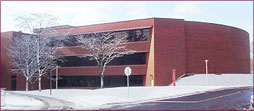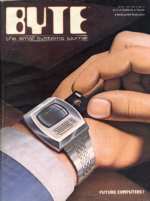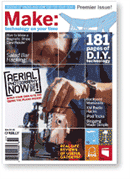 Back in the early 1980s, after I turned 16 and could borrow my parents’ car, I used to drive down into Hamilton to the H.G. Thode Library of Science and Engineering. Because the library building is round, because it’s located next door to McMaster University’s own nuclear reactor, and because of the library’s futuristic-sounding nickname of “Thode,” it felt a lot like driving down into the future.
Back in the early 1980s, after I turned 16 and could borrow my parents’ car, I used to drive down into Hamilton to the H.G. Thode Library of Science and Engineering. Because the library building is round, because it’s located next door to McMaster University’s own nuclear reactor, and because of the library’s futuristic-sounding nickname of “Thode,” it felt a lot like driving down into the future.
My reason for driving to Thode was that they had subscriptions to both Byte and Creative Computing magazines (both published in Peterborough, NH near Yankee as it turns out). For a geekly,  curious teenager like me, those magazines were fascinating reading, and I regularly photocopied pages of BASIC programs from their pages and took them home to type into my TRS-80 Model I.
curious teenager like me, those magazines were fascinating reading, and I regularly photocopied pages of BASIC programs from their pages and took them home to type into my TRS-80 Model I.
One of the features of Byte back in the day was a column called Ciarcia’s Circuit Cellar. Written by engineer Steve Ciarcia, it was a monthly “DIY” column that showed you, say, how to make your own remote control for your television, or how to make a 1200 baud modem. Most of what was covered in the columns was way, way above my head (I could barely manage a soldering iron, and still can’t), but the notion that the technological world could be so malleable was extremely alluring to me, and I looked forward to each new issue.
Several years later, after moving up to Peterborough, I discovered Coevolution Quarterly, which grew out of the Whole Earth Catalog and later became Whole Earth Magazine (and which recently gave up the ghost). While the Whole Earth sensibility was different, it was still firmly rooted in the “DIY” ethic: self-reliance, access to tools, and so on.  I became hooked, and bought every back issue I could lay my hands on.
I became hooked, and bought every back issue I could lay my hands on.
In the same vein now comes a new quarterly, Make: magazine from O’Reilly. My first issue arrived today in the mail, and I’m happy to report that it reads like the spiritual ancestor of both Circuit Cellar and Whole Earth. It’s about malleable technology, hacking, self-reliance, and remodelling the world. It’s a spirit I still love, and even if I don’t build a rig to let me take aerial photographs from a kite, or hack my XM satellite radio, I’ll still slurp it all up eagerly.
Make: has a weblog where you can gather their ethic via RSS. It’s a worthwhile print subscribe, though, if you share my passion for going malleable.
I was expecting to be able to return to the Formosa Tea House tomorrow for lunch; alas walking by today I saw a sign on the front door advising that they’ll not reopen until this Friday, February 25. Three more sleeps.
 I’ve got an icon problem. Look at the screen snip here: it shows a section of my Mac OS X dock, with icons for (from top to bottom) Mail, Firefox, NetNewsWire, MarsEdit, YummyFTP, CocoaMySQL and BBEdit.
I’ve got an icon problem. Look at the screen snip here: it shows a section of my Mac OS X dock, with icons for (from top to bottom) Mail, Firefox, NetNewsWire, MarsEdit, YummyFTP, CocoaMySQL and BBEdit.
It’s the five round icons in the middle that are causing me problems: they all look the same. I don’t mean “look the same” in the sense that they are visually identical, but rather in that flick of a second when I’m navigating from one application to the next, or selecting an application from the dock, they’re similar enough so that it’s easy to confuse one for the other.
About half a dozen times a day, I find myself, say, clicking on YummyFTP when I meant to click on CocoaMySQL.
I’m not sure if this is a failure of the OS, or a failure of the icon designers, or a failure of my own visual processor. Or not a failure at all.
But it does seem that a lot of OS X applications use an orby sphere as the superstructure of their icon — perhaps inevitable given the whole “worldwide” part of the www — and that is the basis of the visual confusion.
Can anyone tell me why a Google image search for site:almanac.com produces lots of results, but a similar image search for site:ruk.ca produces no results?
My old friend Leah is producing Read-TV, “an innovative series on video and DVD that engages and educates beginner readers.”
Our copy arrived today, and Oliver is captivated. Oscar. Makes. Muffins. If you have a child of pre-school to grade one age, you should take a look; full story, and online ordering on the Read-TV website.
Back last September when this weblog got all personal, I let our corporate website wither on the vine.
I’ve started to water and feed it this week, and because we’re starting to use it to make a lot of client websites, I’m using Drupal to do it. Consider it a work in progress, and as much an experimental sandbox as a piece of business propaganda. Look there for news more “corporate” than personal, including notes about important updates to our client websites, interesting projects, and the like.
You can find it all at the new Reinvented.net. There’s an RSS feed over there too.
From my friend John comes a pointer to Radio Free Peterborough, founded to answer the question “I wonder how much Peterborough music you could put together in one place on shuffle?”
My erstwhile alma mater Trent University is the subject of a news weblog that purports to “advocate for accountability and transparency in university governance.” Things were so much simplet back in the 1980s when the issues of the day were things like renaming the “Bata” library the “Biko” library.
 I am
I am